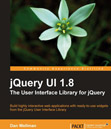I recently had a situation where I had built something for a client, tested it, etc and made it live. It worked as intended on ‘normal’ computers, but my boss, who has an iPad, found that it didn’t work at all on the iPad. Well, I say it didn’t work at all, it kinda worked, although it very definitely didn’t work as intended.
The thing in question was an animated hero panel, with navigation buttons along the side, which enabled the visitor to see different panels of content by clicking the buttons. Pretty standard stuff, nothing funky, nothing crazy, just bread ‘n’ butter jQuery, so you can imagine my surprise when it didn’t work on the iPad.
What was actually happening was that a single click was being treated as a hover, and so the active style was being applied to the navigation buttons when one of them was pressed a single time. If then pressed a second time, the animation/content change was being applied. Interesting.
Fixing the issue turned out to be surprisingly easy, we just need to sniff the userAgent string and look for iPad. Yes, I just said sniff the userAgent. I know, right?! We stopped doing userAgent-based browser detection years ago. But that indeed was the advice I found while browsing the developer docs over at apple.com, and it worked, which is of course the main thing.
The code turned out to be as simple as this:
var ua = navigator.userAgent,
event = (ua.match(/iPad/i)) ? "touchstart" : "click";
$("theElement").bind(event, function(e) {
//do shit here
}
We just try to find the string iPad in the userAgent string (specifying the case-insensitive flag), and set the event to touchstart if it is found, or click if it isn’t. We then just pass the event variable to the jQuery bind() method and supply an anonymous function as we normally would.
Changing the code to the above from what it was originally, $(theElement).click(function() { });, fixed the problem entirely, and the intended behaviour of triggering the animation/content change with a single click (or touch) was restored.







[...] This post was mentioned on Twitter by Dan Wellman. Dan Wellman said: fixing click events for the iPad when using jQuery: http://is.gd/jfXBm [...]
Nice trick! Seems like this should be applied to the iPhone as well?
Also, this vaguely reminds of a jquery fadeIn speed trick from a Paul Irish video: http://www.youtube.com/watch?v=i_qE1iAmjFg#t=18m
Thanks :D
Yeah, it should work just as well on the iPhone with a little tweak that looks for ‘iPhone’ as well as ‘iPad’ in the user agent string…
Thanks for posting this.
I was struggling for an answer to this double click issues for a few days now!
cheers!
-d
In my case I was using .click(function() …) on a select tag which worked ok on everything except ipad and iphone. I simply changed the ‘.click’ to ‘.change’ and it fixed the problem.
That’s a great tip Frank, thanks for sharing :) It would only work for elements that fire a change event, such as form controls, but useful nontheless
thanks it worked for meto …but now IE browser is giving the JS error, this obeject is not supported in IE. and error is pointing to line which i added
which line does it refer to?
Why not just run:
$(“element”).bind(“click touchstart”, function(){
alert(‘Code here’);
});
Since the click event wouldn’t get registered on devices that are interpreting it as a hover. Yes, it’s not the most efficient method, but it would solve the problem for all iOS devices and potentially android devices (haven’t tested if they are affected by this issue).
Have you tested? If this works it would be pretty cool, although as I mentioned in the post, it isn’t that iPad doesn’t fire click events, just that it handles them differently (e.g. firing them on a double click insteasd of a single click), so binding to both click and touchstart may have some undesired/unforseen effects…
I guess it’s swings and roundabouts – as you say this code isn’t the most efficient, i.e. it registers two events when only one is required, however, it does (if it works) enable us to move away from sniffing the user-agent :)
I’d be interested in testing it, could be a good excuse to finally get an iPad!
Great great great easy fix. i was getting a little frustrated trying a few things and this instantly fixed the issue. thanks for posting.
ps- works just fine if you change it to iPhone as well
Could someone show how i would insert this code to get my nav buttons working on ipad,ipod and iphone at this site.
http://www.neteffectrollon.com Thanks!
You need to put it inside the jQuery document ready function (if you’re using it) but before any event handlers that rely on the click (or touchstart) event
This worked perfectly! Great job! Thanks for sharing…
Hi Dan
This seem exactly what I need. I tried to implement this solution on an Image map (the exact same one as here http://www.svennerberg.com/examples/imagemap_rollover/index_jquery.html)
I just change their JS event to the following but IPAD is having none of it. Any idea ?
Thanks
C
var ua = navigator.userAgent,
event = (ua.match(/iPad/i)) ? “touchstart” : “click”;
$(this).bind(event, function(e) {
e.preventDefault();
var country_id = $(this).attr(‘id’).replace(‘area_’, ”);
alert(‘You clicked ‘ + country_id);
});
I saving the pic but it’s not showing up other than in the album cover. Do you know what’s up?
That works very well!! Thanks
I encountered this issue also but took a slightly different approach as we happened to be using Modernizr alongside jQuery. Just used the test for touch capability instead and pretty much any device gets covered:
if(Modernizr.touch){
event = “touchstart”;
} else {
event = “click”;
}
$(“theElement”).bind(event, function(e) {
//do shit here
}
There is an issue (tested on iPad 3) where if the user touches one of these objects with the click/touch handler attached when scrolling. I.e., the user places their finger on the screen to begin a scroll gesture, BUT, the touch event fires immediately.
So, if you have a button with the touchstart event set, and the user happens to touch this when scrolling, the event will fire even though it was not the users intention.
‘touchend’ should be used to avoid this.
Great tip, thanks Sam!
The use of touchend suggested by Sam also can cause trouble. The possible solution is to compare the positions at touchStart and touchend occured and also the timegap between them. If those satisfies to be a ‘tap’ then do the logic for tap.
Another opinion to bind both touchstart and click on same event can also be buggy. touchstart gets fired as soon as finger is touched. click is an interface event that will be fired after the finger is pulled back and gesture is completed. So this might lead to triggering the handler twice.
Possible solution is to retain your idea of checking the event type, but using the touch tester by Modernizer [if(!!('ontouchstart' in window) )] will cover more devices. Then instead of just using touchstart some logic to determine tap accurately can be implemented.
Do you hate Android? Because you just ditched millions of Android devices with this solution. Try this instead of sniffing for iPad/iPod in the UA:
var isTouchSupported = “ontouchend” in document;
Do I hate what? Ha ha, just kidding. No I don’t hate Android. This post is what 18 months old now? There are much better ways of doing this now, and you’re right, it is wrong to exclude Android, or any popular platform :)
Thanks for the post it helped me big time, thanks alot again :)
Hi, this code will work but I have some extra consider that this will make some potential issue because ontouchstart in IPAD fires once your figure touch the button, and the it same as the mouse down event in desktop in my mind.And in IPAD/IPHONE, when you use if you will find some conflict with touchmove event. I think the appropriate logic for figure click is. 1. figure down touch the object 2. figure up and with touch the same object then fire the function if not cancel.If I have anything wrong or you want to discuss more, please send me email.
Thanks.
Thanks.. works like a charm.
this might work but is not a real solution, why some links with jquery click even will work and other don’t, better focus on that, and find a fix that way.
[...] schlicht die Infos dieser Seite, um für das iPhone und das iPad das touchstart Event zu verwenden. http://www.danwellman.co.uk/fixing-jquery-click-events-for-the-ipad/ (function($){ var options = {"info_link":"http://heise.de/-1333879","txt_help":"Wenn Sie diese [...]
You can use jQuery .on method and bind both click and touchstart
.on(‘click touchstart’,'#thing’,function(e){})
Here is a fiddle: http://jsfiddle.net/hyxdc/
Excellent tip, thanks a lot :)
[...] drove me nuts. I found a person that also had a click issue posting about their oddity. Slightly different for them, but the fix is [...]
Thanks for your posts!!! ^^
You might be interested in https://github.com/ftlabs/fastclick
which handles the problem of the delay (300ms) causing some events to fire twice (like AJAX calls).
binding the “touchstart” event is annoying, as the user can’t scroll the page from the element the event was bind to.
I found another global solution, which works great as much as I tested.
After detecting mobile or tablet, i then trigger an elements click event on hover:
$(“a, div”).hover(
function(e){
e.preventDefault();
$(this).trigger(“click”);
}
);
メンズサンダルブランド 靴 激安 http://www.baidulen.com/
great…..its worked for me
i think we can use multiple events trigger for 1 element
$(“element”).bind(‘touchstart click’, funtion(){
//do somthing here
});
You could just bind the handler to both in this case:
$(“theElement”).bind(‘touchstart click’, function(e) {
//do shit here
}
Howdy! I’m at work surfing around your blog from my new iphone!
Just wanted to say I love reading your blog and look forward tto all your posts!
Keeep up the excellent work!
I have the click handler for input type = search, but when the ipad’s keypad is open, then it doesn’t work. But when we close the keypad then it works.
I’m guessing that using this technique on a text input is not going to be as smooth due to the interaction with the on-screen keyboard. It was used originally with anchors that had click handlers attached. Think about the interaction when using any type of text input – when you click the input, it’s going to open the OSK. Have you tried preventDefault() inside the event handler?
Thank you! It works fine here.
[...] i found a solution on http://www.danwellman.co.uk/fixing-jquery-click-events-for-the-ipad/ [...]
[...] 我在http://www.danwellman.co.uk/fixing-jquery-click-events-for-the-ipad/上找到了解决方案 [...]